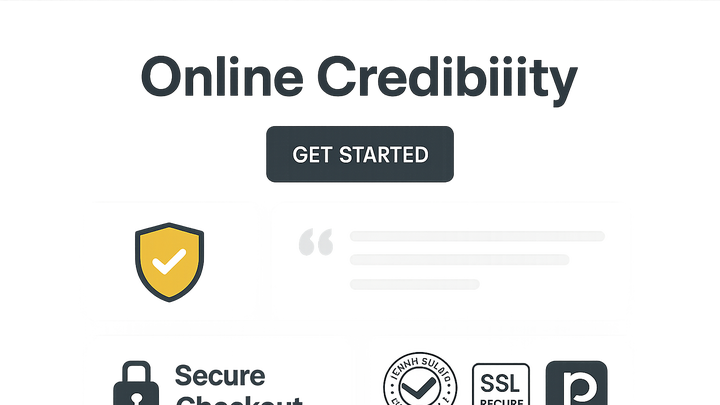Published on 2025-06-29T19:23:45Z
What Are Trust Signals? Importance & Examples
Trust signals are visual or textual cues on a website that help establish credibility, reliability, and safety in the minds of visitors. They reassure potential customers that your site is trustworthy, encouraging them to take desired actions such as making a purchase, signing up for a newsletter, or filling out a contact form. For example, security badges, customer testimonials, and recognized third-party certifications serve as powerful trust signals. In the context of CRO, UX, and SEO, well-placed trust signals can reduce bounce rates, improve conversion rates, and even boost search engine rankings by demonstrating site quality. Tools like Prevue.me can audit your site to identify missing or weak trust signals, offering actionable critiques to enhance lead generation, accessibility, and overall user experience. By continuously testing and refining these signals, you can adapt to evolving user expectations and maintain a competitive edge.
Trust signals
Elements like badges, testimonials, and certifications that build website credibility, boosting CRO, UX, and SEO.
Why Trust Signals Matter
Trust signals serve as credibility boosters that reassure visitors, build confidence, and encourage conversions. Without them, users may hesitate to engage with your site or provide personal information.
-
Conversion uplift
Visible trust signals reduce anxiety and skepticism, often leading to higher completion rates for purchases, sign-ups, and other key actions.
-
Improved engagement
By demonstrating reliability, trust signals can lower bounce rates and increase time on site, fostering a deeper connection with your audience.
-
Enhanced seo signals
Search engines favor secure, credible sites—elements like SSL certificates and privacy policies can indirectly boost rankings by improving user metrics and site authority.
Common Types of Trust Signals
There are several categories of trust signals, each serving a unique purpose in reinforcing your site’s credibility.
-
Security badges
Icons or seals indicating SSL encryption, PCI DSS compliance, and secure payment processors that protect user data.
-
Customer testimonials & reviews
Real feedback from users, including star ratings and quotes, that showcase positive experiences and outcomes.
-
Trust seals & certifications
Third-party accreditations like BBB, Norton Secured, or industry-specific certifications that validate your business practices.
-
Privacy policies & terms of service
Clear links to legal pages that outline how user data is collected, used, and protected.
-
Social proof & media mentions
Logos of well-known clients, publications, or social follower counts that highlight widespread recognition.
Best Practices for Displaying Trust Signals
Proper implementation ensures trust signals are effective without overwhelming or distracting your users.
-
Strategic placement
Position trust signals near calls to action (CTAs), in the page header or footer, and on checkout pages to reinforce credibility at critical moments.
- Above the fold:
Place a key security badge or testimonial where it’s immediately visible without scrolling.
- Checkout and forms:
Reiterate site safety near payment fields and submission buttons.
- Above the fold:
-
Consistency & design integration
Ensure badges and seals match your site’s visual style to maintain a cohesive brand experience.
-
Authenticity verification
Use genuine reviews and up-to-date certifications; avoid fake or expired badges that can harm your reputation.
-
Mobile optimization
Display trust signals prominently on mobile layouts to accommodate smaller screens and ensure clarity.
Measuring Trust Signal Effectiveness
Regular analysis and testing help determine which trust signals resonate with your audience and drive results.
-
A/b testing
Experiment with different badges, positions, and messaging to identify the most impactful combination.
-
Analytics metrics
Monitor conversion rates, drop-off points in the funnel, time on page, and bounce rates to gauge performance.
-
User feedback & surveys
Collect direct feedback on which elements make users feel secure and which might cause doubt.
-
Heatmaps & session recordings
Visualize where users focus and click to ensure trust signals capture attention without clutter.
Leveraging Prevue.me for Trust Signal Optimization
prevue.me offers tailored critiques across CRO, SEO, UX, and accessibility to help you audit and enhance your trust signals.
-
Cro critiques
Analyzes your site to highlight missing or weak trust signals in high drop-off areas and recommends improvements.
- Landing page analysis:
Identifies key credibility gaps in hero sections and CTAs.
- Landing page analysis:
-
Seo insights
Flags trust factors like missing SSL, outdated schema markup for reviews, and provides SEO-centric recommendations.
-
Ux & accessibility review
Ensures trust signals are visible and accessible, with proper alt text and color contrast for all users.
-
Lead generation recommendations
Optimizes form placements, CTA designs, and trust indicators to maximize lead capture efficiency.
